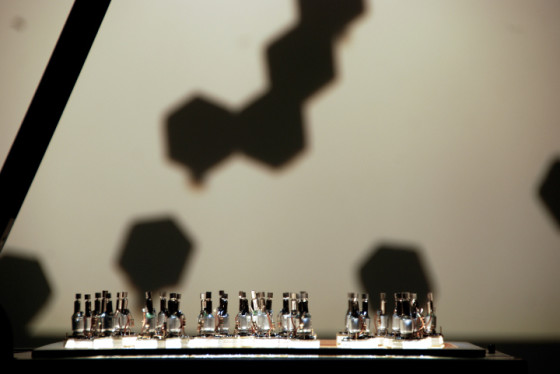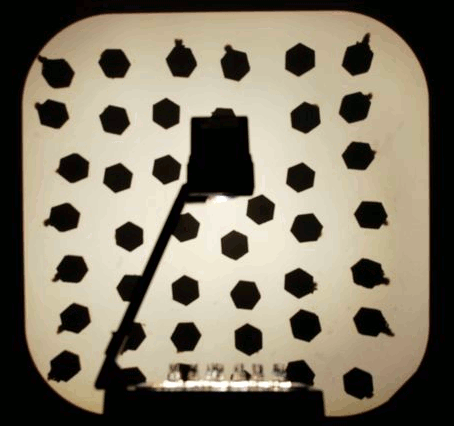Project description
The crystal forming robots are a physical simulation of a growth process, similar to the growth of crystal structures. Each robot operates autonomously and is driven by the light of the overhead projector. When a robot has collected enough energy through its solar panel, the energy is all released at once through a small motor and the robot will make a random movement. The robots are equipped with tiny magnets, so that when they come close while they are moving, they attract each other and dock together. Over time a crystal-like structure emerges from more and more little robots forming larger clusters. Through the overhead projector this process is magnified and an abstract real-time movie of the real physical robots is projected to the wall.
The background of this project is research on systems of growth, self-organization and plastic change. The core idea is to use robots to make the process of growth tangible and to develop an experimental system to study growth and the self-building of networks. The robots are a physical realisation of an algorithm that models the growth of crystalline structures, the diffusion limited aggregation algorithm. A detailed article, describing how the full system operates, appeared this year in the conference proceedings of xCoAx 2014, Conference on Computation, Communication, Aesthetics and X, Porto, Portugal 2014
An interview on the project was published on the art and design blog we make money not art.
Proposal for the Japan Media Arts Festival
For the Japan Media Arts Festival I would like to propose a new installment of the piece that highlights the different structures that emerge over time. The basic idea is to use hand-drawings to document the different end-states of the crystallisation process.
Initially the robots are placed on the overhead projector in a regular chessboard-like pattern, after about an hour they all have clustered into either one large crystal like structure or into two or three larger clusters. At this moment the process has converged and the robots should be manually reset into the chessboard pattern. Then again the robots will self-assemble into crystal like structures, that look similar to the previous structures at first glance but that differ in every detail.
To document this process I would like to project onto a white paper-canvas and use a black brush or marker to draw the outlines of the final projected structure. Every hour, when the crystal building process has converged the outline of the new structure is drawn by hand on top of the previous one and over time on the canvas a layered image is created. This drawing tells the history of all repetitions and documents all the variations between the different runs.
For the installment at the Japan Media Arts Festival there should be two projectors, first a projector with the robots and second an empty projector just used to highlight a second canvas with the traces of previous experiments. I will create this canvas over the next months till the festival. Along with the first projector there will be an instruction set for visitors, how to re-place the robots after the crystal building process has converged and an invitation to draw the outlines of the robots on the canvas on the wall.
Resources


downloads
- Article from xCoax
- Interview with we make money not art
- Movie
- detailed description
biography
Christian Faubel works at lab3, the laboratory for experimental computer science
at the Academy of Media Arts Cologne, he does performances with the projectorband ray vibration and with derstrudel he teaches workshops at the edge of science and art and creates installations that are self-sustained habitats using autonomous robots.
After studying mechanical engineering in Toulouse, France and Dresden, Germany he became interested in autonomous systems during an internship at Sanyo Denki. There he worked on an small sized autonomous robot within Sanyo’s household appliances research and development department in Osaka, Japan from 1999 till 2000.
When he returned to europe in 2001 he worked for a short period as a freelancer for the Fraunhofer IPA in Stuttgart and for the Technical Collections Dresden. In 2001 together with Sebastian Noth he founded derstrudel to give structure to their shared interest in simple analog robots, in all sorts of electronic tinkering and the mediation of relaxed approach to electronics. Workshops and installations of derstrudel have been featured at numerous venues, including the garage festival, the transmediale, the piksel festival, the international film festival rotterdam, the art of the overhead, centre pompidou paris, sight and sound festival montreal.
in 2002 he started to work in the autonomous robotics group at the Institut für Neuroinformatik in Bochum. After working on dynamical systems for robot navigation, in 2004 he focused on autonomous perception and object recognition based on dynamic neural field theory. In 2009 he finished his phd and continued to work at the Institut für Neuroinformatik as a postdoc. In 2012 he started working as member of the artistic/scientific staff at the Academy of Media Arts Cologne.